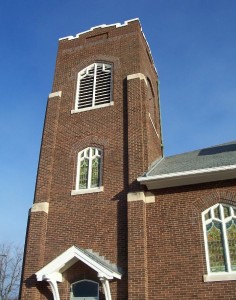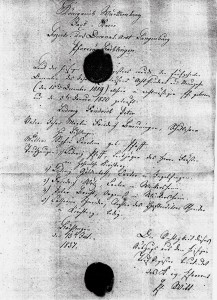This is the bell tower of Zion Lutheran Church, Chattanooga. Nowadays we hear the church bell ring on Sunday mornings, but many years ago church bells rang every day and played an important part in the daily lives of the people of the church and the community.
When my great-great-grandfather Louis Breuninger came to America from Württemberg in about 1840 he brought with him a blue paper with a red wax seal on it. The wax seal is still on the paper! It was a copy of his baptismal record, dated 13 July 1837. Since he was born in 1819 I assume that he had this copy made to bring to America with him.
The document shows that Louis was born on 15 December 1819 and was baptized Louis Friedrich Peter Breuninger on 3 January 1820. His parents were Johann Martin Friedrich Breuninger, a schoolteacher in Bachlingin, and Sophia Carolina, born Pfaff.
Witnesses [taufzuegen] at his baptism were:
Ludwig Pfaff, a soldier from Kirchberg
Ludwig Goldenboth, a bell-ringer [lauter] from Ingelfingen
Friedrich Wolz, a bell-ringer from Weikersheim
Peter Brecht, an organist from Weikersheim
Catharina Schneider, from the abbey in Kirchberg
If you locate those towns on a map you will see that they are very close to Ruppertshofen, where the Schumms came from.
With witnesses that included two bell ringers and an organist I am sure they all made a joyful noise at Louis’ baptism.
Were there bell-ringers in the Breuninger family? Were bell-ringers close family friends? Or did the bell-ringers and the organist just happen to be at the church and available to witness Louis’ baptism? We may never know.
Bell-ringers were important and busy people in Germany two centuries ago. They were often members of organized companies which may have been separate from the church. Apparently they were a rather rowdy bunch because these groups usually had a code of conduct hanging in the ringing room.
Church bells date back to about 400 AD. They became common in Europe during the early Middle Ages.
Nearly every church had at least one bell and many had several. Different combinations of bells might signal the start of the service, various services such as weddings or funerals, or even if there would be a sermon. Bells would be rung vigorously for a wedding and slowly for a funeral.
A church bell was tolled to announce the death of a parish member. A toll bell, or death knell, is rung slowly, about once every 4-10 seconds. It was usually tolled once for each year of the person’s life. The age of the deceased was sometimes tolled in a pattern. For example, if the deceased was 75 years old, the bell would be tolled seven times for seventy, a pause, then five more times to indicate the five. The toll might also denote the sex of the deceased: three times three strokes for a man and three times two for a woman.
Before mass communication church bells were rung for both church and secular functions. Church bells were the best way to inform and gather the people of the village together. They may have been rung to indicate the time, to warn of dangers or emergencies such a fire, to sound curfews, and to announce important events and great victories.
Zion, Chatt, has one church bell. It was donated by the Hartsock family years ago. It is a swinging bell with two ropes that swing the bell so it strikes the clapper. There is a third rope attached to a hammer/striker that will toll the bell. This produces a softer sound and my dad prefers to toll the bell by carefully pulling one of the other two ropes.
Our bell is rung at the beginning of the church service but I remember when it also used to be tolled three times during the Lord’s Prayer, at the beginning, in the middle and at end of the prayer. Our bell is also tolled for funeral services, when the hearse arrives.
Some of our members remember when the bell-ringer tolled the bell when someone died. Members of the church and the community usually knew if a church member was very ill and the tolling bell was a way to communicate that the person had passed on. This is no longer done at Zion, Chatt.
However, Zion, Schumm, still tolls their bell when a member dies—once for each year of their age. My grandma Schumm passed away at age 101. That was a lot of tolling. Their bell is tolled at a specific time of day. If a person dies during the night the bell is tolled at 8:00 a.m. and if someone dies during the day the bell is tolled at 4:00 p.m. Some of Zion’s members still pause to listen for the church bell at 8:00 and 4:00 each day.
Johnny Reef was the bell ringer at Zion, Chatt, for many years. Over the years others have taken up the task: my dad Herb Miller, Don Caffee, and currently Don’s son Kevin. As far as I know our bill-ringers do not belong to an organized company and have never needed a code of ethics.
I have talked to bell ringers past and present from Zion, Chatt, and they all have the same thing to say: DO NOT pull the ropes so hard that you turn the bell over. Apparently this is a very bad thing that involves climbing up the bell tower to right the bell so it can ring once again.
“For bells are the voice of the church…” Henry Wadsworth Longfellow
Some bell links:
http://allsaintswokinghambells.org.uk/AbHistory/index.html :
http://cccbr.org.uk/pr/pubs/bellsandbellringing/
http://en.wikipedia.org/wiki/Funeral_toll :
http://www.verdin.com/bells/church-bells.php
http://wiki.answers.com/Q/What_is_proper_church_bell_ringing_etiquette#ixzz1lifWeJd0
http://www2.dvhh.us/feketitsch/book/75-80.htm





